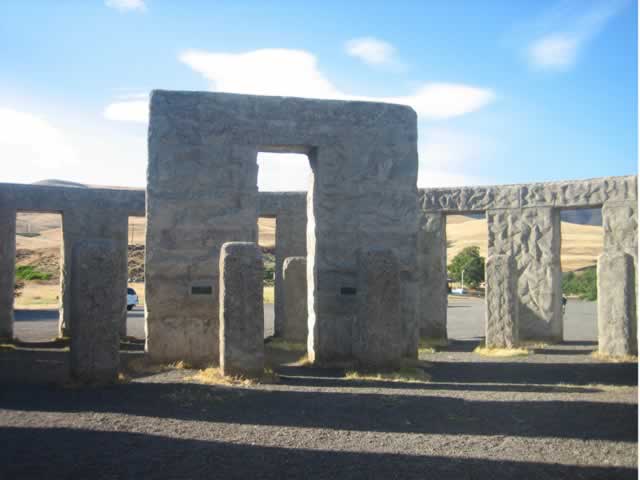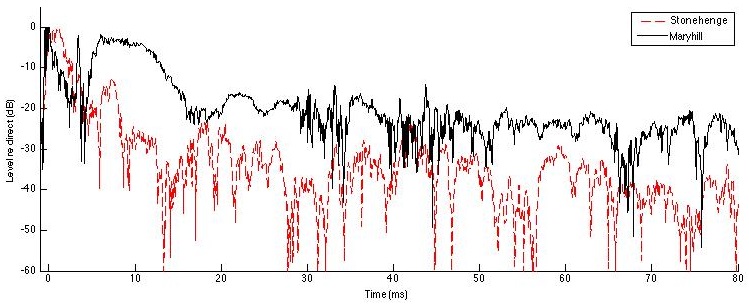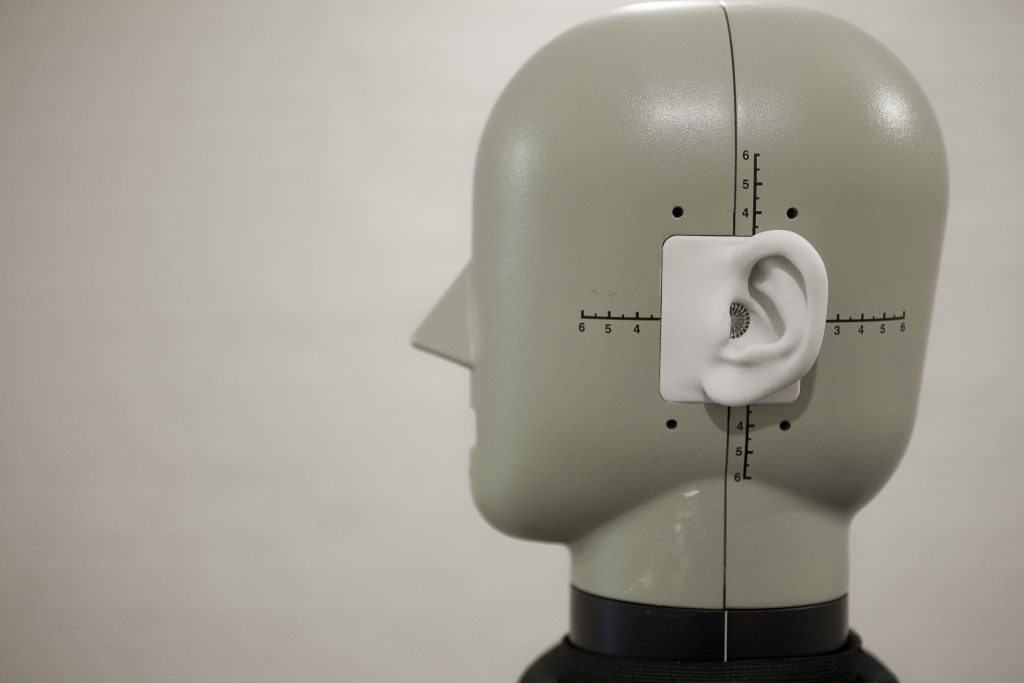Acoustics of Stonehenge
Dr Bruno Fazenda, 2012
Acoustics Research Centre, University of Salford
Ever wondered what it sounded like in Stonehenge 3000 years ago?
Archaeological studies of pre-historic sites, such as Stonehenge, have often overlooked the auditory sense. In its original form Stonehenge had concentric shapes of stone rings which would have surrounded an individual both visually and aurally. It is an outdoor space and most archaeological evidence suggests it did not have a roof. However, its large, semi-enclosed structure, with many reflective surfaces, would have created an unusual sonic environment for the Neolithic Man.

The preservation and recreation of the acoustics of ancient places is vital. In recent times, this branch of acoustic science has been named archaeoacoustics. It is important in the reconstruction of ancient theatres and aids in the archaeological interpretation of important buildings and heritage sites, some of which may not exist in their original form. With the correct measurement and modelled data, the original soundfields can be recreated to allow researchers and the general public to experience the sounds in interactive applications.
Since its disintegration into ruins no one could tell how standing inside Stonehenge sounded like. Then, on the 14th April 2011, people attending the Meet the Scientist series at the Museum of Science and Industry in Manchester, could, for the first time, step into a fully immersive rendering of the sounds of birds singing, children giggling and a folk band playing, inside Stonehenge. This public demonstration was the result of a research project that for the last 3 years had been studying the acoustics of Stonehenge and recreating its aural environment as an extension to multimodal and ecologically valid archaeological studies.

Work on this project has taken the research team, which involves academics from the Universities of Salford, Huddersfield and Bristol, to the Stonehenge site in the United Kingdom and to a full-sized concrete reconstruction in Washington State, USA, built in 1929 as a memorial to the soldiers of the First World War.
The acoustic response of the now derelict Stonehenge site has been analysed but since many stones are missing or have been moved the results are not representative of the original building. The present day Stonehenge exhibits a few weak echoes and no noticeable reverberation, which is quite typical of an outdoor space. In contrast, the replica site in Maryhill is a much more faithful visual and aural representation of the original monument, as it is believed to have existed around 1500 B.C. At Maryhill, a short reverberation, typical of a small auditorium or a lecture hall, can be heard!
Acoustic Measurements
Acoustic measurements and state of the art acoustic modelling have been used to investigate the existence of audible effects at Stonehenge, such as echoes, resonances and whispering gallery effects. The finding of such effects could go some way into supporting claims of acoustic intentionality in the design of the space.
The measurement of acoustic response within the current Stonehenge has shown a very short reverberation time (0.48 seconds), which is expected due to the reduced number of standing stones. The measurements of Maryhill however, reveal a reverberation time of about 0.8 seconds. This type of reverberation is typical for example in a lecture hall where good speech intelligibility is required.

Figure 3 – Energy Time Curves for Stonehenge and Maryhill. These curves show the behaviour of sound energy as it decays with time after an initial excitation impulse. It is clear that Maryhill sustains reflected energy for a longer time, giving rise to the impression of a more reverberant environment.

Figure 4 – Reverberation Times for Stonehenge, Maryhill and a Wave Field Synthesis auralisation.
Although this study has found no spectacular acoustic effects, it is clear that such a space does react to acoustic activity such as speech and chanting. Considering that the Neolithic Man might only ever experience reverberation or echoes at relatively rare spaces such as caves or natural features (hills and cliff faces), this is an interesting and untypical acoustic response, certainly noticeable by people using the space. A modern day equivalent might be the perception we get when we step into a church or a cathedral. The effects found do not unequivocally suggest acoustic intentionality in the design but they go a long way to revealing what our ancestors might have felt when they stepped into Stonehenge.
Differences in reflective surfaces and material
One of the first questions that typically gets asked is ‘how much does the difference in material between stones (at Stonehenge) and concrete (at Maryhill) have in the acoustic response?’ In my view, not much. Both materials are quite massive and highly reflective over the frequency range of interest. The stones at Stonehenge are naturally less regular in shape, which causes some mid to high frequency diffusion. However, the concrete stones at Maryhill have also been worked to have non-flat surfaces. Irregularities are in the order of 10cm deep in both sarsen stones as in the concrete ones. Because they are more regular, diffusion from the concrete ‘stones’ may only exist at higher frequencies when compared with Stonehenge. If this is the case, then Maryhill would be a ‘worst case scenario’, where more focussing and higher levels of reflected energy exist. At the lower frequencies, both structures are acoustically similar.
Through different particular routes however, both surfaces will cause a fair amount of diffusion at mid to high frequencies on the impinging sound waves. The net result within the circle is likely to be the same. In sum, any patterns that were likely to exist at the original Stonehenge site will be revealed at Maryhill with similar objective measures such as reflection times, reverberation and interference patterns or resonances. Some further investigations are currently being undertaken in order to determine the reflection coefficient of the Stonehenge stones.
Modelling
Stonehenge was a circular shaped building. In such architectures one would expect strong focusing effects where sound is reflected to the centre of the space from the surfaces around it. Anyone standing in the centre of the space and making a sound, say a handclap, would expect an echo to return from the boundaries. However, Stonehenge is not simply a circular architecture with a free space between the centre and the periphery. There are many stones, the blue stone ring and the Trilithons, which reflect and diffract sound waves as they travel away from the centre. These reflection and diffraction effects create something close to what in acoustics is know as a diffuse field, meaning that sound waves at any point in the space are likely to be travelling in many directions rather than from a specific direction.
This, in turn, prevents any sound wave to arrive back at the listener with a single and defined time delay and a strong level, which would have sounded like an echo. Instead, the perception is that of a reverberant space, with no defined echoes from specific directions. Curiously, such a space tends to be supportive of speech activity since a speaker can be heard reasonably well from anywhere in the space, including when standing behind one of the stones (but within the outer circle). This effect was quite clear when we visited the Maryhill site for our study.
A Finite Difference Time Domain acoustic simulation of Stonehenge has been produced by Jonathan Sheaffer, one of our PhD students. The effects of reflection and diffraction as the wavefronts meet the stones can be seen in the following animation. After a while it is clear that wavefronts, which started off clearly defined as they leave the source position, turn into wavelets travelling in every direction, suggesting a diffuse field.
Figure 5 – FDTD simulation of a source in the centre of Stonehenge.
One other acoustic effect that might be expected in circular buildings is that of the whispering gallery. This is an effect found before in St. Paul’s Cathedral in London. The whispering gallery effect makes sound waves travel around a curved inner wall until they reach another distant location on the wall. Whispering gallery effects were reported as a useful way of passing information, in the form of whispers, from one point near the wall to another point so far away that direct, straight line propagation would not be heard. In some places, such as the Grand Central station in NY, this effect is even said to be used for marriage proposals!
We have used the FDTD model to investigate why Stonehenge, although having a circular shape with a defined peripheral corridor, did not exhibit this effect. The answer is once again due to the large amount of diffraction that exists as the sound wave propagates along the stone-gap-stone arrangement. This can be seen in the simulation below. The propagating wavefronts get progressively destroyed by interaction with reflected and diffracted waves off the stones and the gaps between them. A clearly defined wavefront is no longer visible after the wave has propagated about 1/8 of the circle periphery.
Figure 6 – FDTD model demonstrating the acoustic phenomena preventing whispering gallery effects in Stonehenge.
Auralisations
The research here at Salford has created a full 3D auralisation of the space to allow experiencing what Stonehenge would have sounded like.
Acoustic Impulse responses (the acoustic footprint) were captured on site using a special technique that requires a microphone capable of measuring pressure, and particle velocity in three orthogonal axis, X,Y and Z. This provides acoustic information about the space such as the time and direction of arrival of reflections. Similar techniques are now common in audio production in the form of convolution reverbs.
To render the soundfield in an immersive environment we have used Wave Field Synthesis (WFS) technology developed by CSE colleagues, Dr Ian Drumm and Mr Rob Oldfield. The system developed uses a ring of 64 amplifiers and speakers, each individually controlled through a computer algorithm. We have developed a hybrid rendering system based on WFS and Ambisonic principles. The method developed is novel yet based on a simple concept:
‘Dry’ sound sources are rendered as focussed sources using wave field synthesis principles. Focussed sources in WFS contain the correct behaviour of wavefronts to give the listener an accurate impression of source localisation within the space. The system is not dependent on listener position, which means a listener can move around freely without losing the correct direction of the sound source. The system also allows real time movement of these sources. A visualisation of focused source can be seen here:
The ‘acoustic response’ of the space is obtained through convolution of the dry source signals and the 3D impulse responses (IR) measured on site. These IRs contain the directional information for direct sound and energy, which has been reflected off the surfaces. The IRs have to be processed in order to remove the ‘direct sound’ information since this already exists in the auralisation space in the form of the focussed sources.
A listener within the rendering system is thus subjected to the correct directional cues generated from the reconstructed wavefronts for the focused sources and the ecologically valid environmental reflections of the space. The system recreates a perceptually accurate environment, where any chosen sound sources are placed within the space and it ‘responds’ to them providing the correct reflections and reverberation. The system effectively provides the aural experience of being inside the circle.
For the demonstrations available here, the auralisations have been processed for binaural reproduction (reproduction over headphones). The principle applied is similar to that explained for the WFS. It is however specific to binaural reproduction:
- Sound sources are generated from ‘dry’ sound recordings and ‘positioned’ in the listening field with the use of corresponding Head Related Transfer Functions (HRTF). I.e. to position a source 30 degrees to the right in front of the listener, the signal for the source is convolved (a mathematical operation) with HRTFs measured at 30 degrees for both right and left ears of a head and torso simulator.
- The reverberant environment, stripped off its direct sound information, is contained in the measured IRs from the site. For each 5 degree direction, the correct weighting of impulse responses in the X and Y direction are convolved with the corresponding HRTFs for both ears and subsequently convolved with the source signal.
The auralisation then contains the correct cues for the dry source signal and the reflected energy from the space surrounding it. The following audio samples should be listened to over good quality headphones for a more realistic result.
Audio Samples
Here’s some clapping outdoors with no surfaces nearby:
This is the sound of the same claps but inside Stonehenge:
And this is an excerpt extracted from a recording of a band called ‘The Imagined Village‘ playing a folk song called ‘Cold Hailey Windy Night’:
Media Coverage
So far, the project has attracted a great deal of publicity. Since the first measurements were taken in 2008 this work has featured in various websites, including the National Geographic, a TV documentary for the History Channel and an article for New Scientist written by our colleague Professor Trevor Cox. The work has also been presented at the first Acoustics of Ancient Theatres Conference (Patras, Greece, 2008) and been published in the Journal Acta Acustica United with Acustica. More recently it has been reported in websites such as the BBC, The Guardian and Scientific American, among others.
A number of invited lectures have also taken place to present this work to a public audience. Wave field synthesis renditions of the sound of Stonehenge have been presented at Museum of Science and Industry in Manchester and at the inaugural event for the BBC Audio Research Partnership at Media City: UK. A permanent rendition can be heard in our Acoustic Research Labs in the Newton building.
For completeness, there are a number of other studies about sound in or from Stonehenge. These links are here to direct the interested reader to other works that look at sounds in the ancient monument:
- Stonehenge bluestones had acoustic properties, study shows (BBC News – Wiltshire)
- Was Stonehenge built for rock music? (The Guardian)
- Stonehenge design was ‘inspired by sounds’ (BBC News – Science and Environment)
- Assessing the acoustics of Stonehenge (University of Bristol)
Finally, if you’re into Stonehenge and autostereograms, here’s a stereogram of Stonehenge to look at as you listen to the audio samples.
